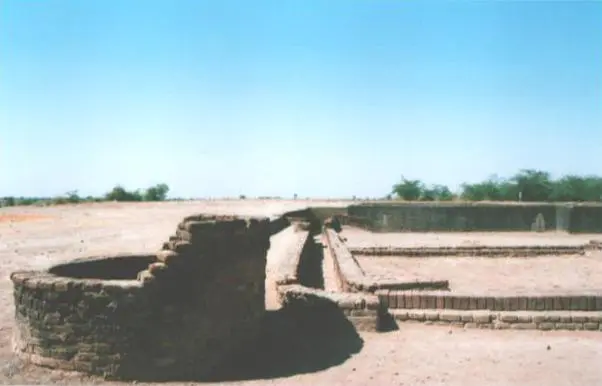Kalibanga Museum is an ancient and historical place in Rajasthan’s Hanumangarh district. Ancient Darshwati and Saraswati river valley At present, the area of the Ghaggar river also originated from the Sandhav civilization in ancient Kali Banga civilization.
Kalibangan is believed to be more ancient than 4000 B.C. Kali Banga was a small town. Here have been found a fort.
Kali bangan was first discovered by Amalananda Ghosh in 1952.
The Kalibanga Museum was established in 1983 to keep the found objects from Harappan digging between 1961-69. Kali Banga Museum is located approximately twenty kilometers from Hanumangarh.
History of Kalibanga Museum
 |
| Kalibanga Museum |
Excavation at Kalibanga place located in Hanumangarh district of Rajasthan, it is known from the remains of the 26-foot-high western mound in 1961.
It is known that about 4000 years ago the Harappan-carpet civilization was flourishing along the banks of the Saraswati river. Kalibanga is located near Pilibanga in the Hanumangarh district.
On-time of the Mahabharata, the Saraswati had disappeared and till the 13th century, it was got it in Sutlej, Vyas. Saraswati was dried in the sandy part due to low water content.
Kalibanga civilization Rajasthan India
According to vakanser, more than 200 cities were settled on the banks of the Saraswati river, which is Contemporaneous of Harappan. For this reason, it should be called ‘Civilization of Saraswati river‘ in place of ‘Civilization of Sindhuti‘.
Archaeological materials derived from Kalibanga which Under the leadership of Rakhal Das Banerjee and Dayaram Sahni in 1922
Through the excavation of Mohan-Jodado and Harappa (now located in Larkana district in Pakistan), the relics of Harappa or Indus Valley civilization were found, from whom the ancient civilization was discovered 4500 years ago.
Later, about 100 centres of this civilization were discovered, in which the Kalibanga region of Rajasthan is very important. After Mohan-Jodro and Harappa, Kalibanga is the third-largest city of Harappa culture.
 |
| Kalibanga Museum |
The excavation of one of the mounds is found in the form of the following relics, whose characteristics make their contribution to the development of Indian civilization –
1. Copper tools and statues
Remnants derived from the excavation in Kalibanga have found copper tools, weapons and idols, which reveal that human stone had entered the age of era.
It was called Kalibanga due to the black copper Bangle found in it. It is important that the word ‘wanga’ in Punjabi means a Bangle, and kalibanga means black bangs.
2. Seals
From Kalibanga, the seals made on the soil of the Indus Valley (Harappa) civilization have been found, on which there are articles in Taurus and other animals and in the scriptures, which have not yet been read. This script was written from right to left.
3. Copper or clay sculptures animal-bird and human creations
Animals have found idols of bulls, monkeys, and birds, which show animal husbandry, and bulls being used in agriculture.
4. Measurement divisions
This era was Using the division of measuring humans was learned.
5. Pots
Various types of pottery have also been received from Kalibanga, which are also painted.
6. Jewellery
Jewelry made of various types of women and men, such as glass, oysters, shellfish, snails etc. is also found, such as bracelets, bangles, etc.
7. Town-planning
Like the Mohan-Jodro and Harappa, there are houses, doors, wide roads, wells, drains, etc. made of brick-cracked bricks made from sun-dried in Kalibanga, which are built according to the pre-plan, on the city-planning, sanitation, drinking water arrangements, etc. of the then human Put light. Unlike Mohean Jodado, Kalibanga’s house was made of brick bricks.
8. Agricultural-related relics
The lines obtained from the solution received from Kalibanga also have been obtained which proves that the human agricultural work was also done here. It is also confirmed by the bull and other pet statues. Bones and bones of barasingha have also been received. Bullock cart toys are also found.
9. Toys
10. Religion Relics
From Kalibanga, the Arctic and oval fireplaces and bulls, the bands of Barsinghee, reveal that here also the animal sacrificed animal sacrifice.
In the form of sources of the above residues, Kalibanga and Indus Valley are their special place in the civilization.
Because some archaeologists have settled on the Saraswati coast, the Kalibanga civilization feels more appropriate to say ‘Saraswati Valley Civilization’
Kalibanga Museum Visiting Time
09.00 To 05.00 PM Everyday
How to reach Kalibanga Museum Hanumangarh
Near Railway Station Kalibanga – Pilibanga 6 KM

My self Dev Satish. I’m an Author and Founder of tourism-rajasthan.com. I’m from Rajasthan and If I talk about my Education then I’m Law Graduate. I love doing work that makes me happy, that’s why I love traveling. you will find Rajasthan travel ideas & tips on this blog.
